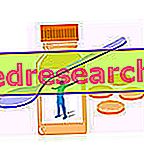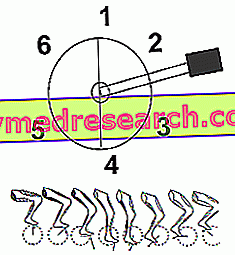Cholesterol is a non-energetic fat contained in animals.
In the body it carries out numerous functions.
It is produced largely from the liver, but is also contained in foods.
It is transported in the circulatory stream thanks to some specific lipoproteins.

Excessive LDL increases the risk of atherosclerosis.
High cholesterol (hypercholesterolemia) is dangerous especially when:
- Increasing it is the fraction of bad cholesterol.
- The fraction of good cholesterol is low.
- There are other risk factors.
Cholesterol, especially the bad one, can get up too much due to:
- Inheritance
- Bad diet
- Sedentary lifestyle.
NB . There is much research on the relationship between cholesterol, diet and sports. However, if it is clear what factors are able to prevent atherosclerosis, the specific mechanisms of action (reduction of total cholesterol, reduction of bad cholesterol, increase in good cholesterol, etc.) are not obvious.
What to do
- Perform blood tests regularly, specifying to mention the details regarding HDL and LDL cholesterol.
In case of positive diagnosis:
- Reduce total cholesterol.
- Reduce bad cholesterol.
- Reduce other risk factors for atherosclerosis and cardiovascular events:
- Obesity.
- Type 2 diabetes mellitus.
- Hypertension.
- Hypertriglyceridemia.
- Oxidative stress.
The means to achieve these goals are:
- Nutritional therapy.
- Motor therapy.
- Supplements and natural remedies.
If the first operation is not effective, the doctor will determine the relevance of:
- Pharmacological therapy.
- Genetic investigation to establish any serious hereditary bases.
What NOT to do
- After an initial diagnosis of high cholesterol, skip the routine checks.
- Follow an inappropriate diet, rich in fatty ingredients of animal origin, junk food and poor in functional plant foods for hypercholesterolemia.
- Do not do motor activity.
- Ignoring overweight: high cholesterol further worsens with the aggravation of obesity.
- Ignore the other risk factors for atherosclerosis and cardiovascular events:
- Borderline conditions of type 2 diabetes mellitus (occasional and prediabetes hyperglycaemia).
- Hypertension.
- Hypertriglyceridemia.
- Do not respect any drug therapies to lower cholesterol.
- Do not investigate the diagnostic investigation for high cholesterol inheritance.
What to eat
To combat high cholesterol, reduce LDL and raise HDL, diet is a fundamental tool:
- Foods rich in omega 3 polyunsaturated essential fatty acids:
- Eicosapentaenoic and docosahexaenoic acid (EPA and DHA): very active from a biological point of view, they are contained above all in fishing products and in algae. They play a protective role against all metabolic pathologies, including high cholesterol. The foods that contain the most are: Sardinian, mackerel, bonito, alaccia, herring, alletterato, ventresca of tuna, needlefish, algae, krill etc.
- Alpha linolenic acid (ALA): compared to the previous ones it is biologically less active. It has the same function as EPA and DHA. It is mainly contained in the fat fraction of certain foods of vegetable origin or in the related oils of: soy, linseed, kiwi seeds, grape seeds, etc.
- Foods rich in omega 6 polyunsaturated essential fatty acids: they have a function similar to the previous ones. They are more abundant in the diet than in DHA, EPA and ALA. On the other hand, nutritional balance requires that no more than 400% be taken compared to omega-3s.
- Linoleic acid (LA): they are rich: sunflower seeds, wheat germ, sesame, almost all dried fruit, corn germ and its oils. The derivatives are:
- Gamma linoleic acid (GLA) and diologamma linolenic acid (DGLA): borage oil is rich in it.
- Arachidonic acid (AA): peanuts and other dried fruits are rich.
- Foods rich in monounsaturated fatty acids omega 9:
- Oleic acid: it is typical of olives, rape seeds, tea seeds, hazelnuts and related oils (in particular extra virgin olive oil). It plays a positive role on cholesterol, very similar to that of essential fatty acids.
- Foods rich in soluble fiber: these are all plant foods that belong to the III, IV, VI and VII fundamental group of foods. Oilseeds and pseudocereals (amaranth, quinoa, chia, buckwheat, hemp, etc.) also abound. On the other hand, they are proportionally more abundant in fruit, vegetables and algae. They exert a viscous function that traps dietary cholesterol and bile salts (internal cholesterol excretion pathway) to expel them with feces.
- Foods rich in vitamin antioxidants: the antioxidant vitamins are carotenoids (provitamin A), vitamin C and vitamin E. They have a beneficial effect on high cholesterol, as they hinder oxidative stress, guaranteeing lipoprotein efficiency. Carotenoids are contained in vegetables and red or orange fruits (apricots, peppers, melons, peaches, carrots, squash, tomatoes, etc.); they are also present in shellfish and milk. Vitamin C is typical of sour fruit and some vegetables (lemons, oranges, mandarins, grapefruit, kiwi, peppers, parsley, chicory, lettuce, etc.). Vitamin E is available in the lipid portion of many seeds and related oils (wheat germ, maize germ, sesame, etc.).
- Foods rich in phytosterols: phytosterols are the alter ego of cholesterol. From the metabolic point of view, they exert a diametrically opposite effect and favor the reduction of cholesterolemia. Recall that some phytosterols simulate the effect of female estrogens, although the extent of this reaction is not entirely clear. They are foods rich in phytosterols: soy and soybean oil, many oilseeds, red clover, cereal germ, fruit, vegetables and dietary foods (eg added yogurts).
- Foods rich in lecithins: they are molecules capable of binding both fat and aqueous compounds; for this reason they are also used as additives. In the digestive tract they bind cholesterol and bile salts, reducing their absorption. On a metabolic level they improve the ratio of good to bad cholesterol and lower the total. They are rich in lecithins: soy and other legumes, egg yolk (but is not recommended in the case of high cholesterol), vegetables and fruit.
- Foods rich in plant antioxidants: the most common are polyphenolic (simple phenols, flavonoids, tannins). Some fall within the group of the aforementioned phytosterols (isoflavones). They behave more or less like vitamins. Lower oxidative stress and optimize lipoprotein metabolism; appear to correlate with a reduction in total cholesterol and LDL. They are very rich in polyphenols: vegetables (onion, garlic, citrus fruits, cherries, etc.), fruit and their seeds (pomegranate, grapes, berries, etc.), wine, oilseeds, coffee, tea, cocoa, legumes and whole grains, etc.
What NOT to Eat
- Foods rich in saturated or hydrogenated fats, especially in trans conformation: they perform a hypercholesterolemic action on the LDL portion:
- Foods with saturated and bifractionated fatty acids: fatty cheeses, cream, fatty cuts of fresh meat, sausages and cold cuts, hamburgers, frankfurters, palm kernel and palm oil, etc.
- Foods with hydrogenated fatty acids, many of them in trans conformation: hydrogenated oils, margarines, sweet snacks, salty snacks, packaged baked goods, etc.
- Cholesterol-rich foods: paradoxically they seem to exert a less hypercholesterolemic effect than the previous categories but are not recommended however. Abound with cholesterol: egg yolk, fat and seasoned cheeses, offal (brain, liver and heart), crustaceans (eg prawns) and certain bivalve molluscs (eg mussels).
Furthermore, it is not recommended to follow a diet mainly based on cooked and preserved foods. Many nutritional principles that promote high cholesterol reduction are sensitive to heat, oxygen and light. It is recommended to consume at least 50% of vegetable products and seasoning oils in raw form (sweet fruit, vegetables and oil seeds).
Natural Cures and Remedies
- Motor activity: it is very important to prevent and treat high cholesterol. Although it is assumed that it acts above all by increasing the good one, what matters is that it drastically reduces the atherosclerotic risk and more generally the cardiovascular risk. Aerobic activities characterized by high intensity peaks are more effective.
- Herbalist based on single products or combinations of: dandelion, artichoke, olive and policosanol.
- Supplements based on oils derived from fishery products:
- Cod liver oil: rich in omega 3 essential fatty acids (EPA and DHA), vitamin D and vitamin A.
- Krill oil: krill is a part of the so-called plankton; as well as omega 3 essential fatty acids (EPA and DHA) it is also rich in vitamin A.
- Seaweed oil: rich in omega 3 essential fatty acids (EPA and DHA).
- Fermented red rice: among its various nutritional characteristics, it boasts a significant concentration of molecules similar to the pharmacological statins used to lower cholesterol.
- Supplements based on oils derived from the germ of cereals: the most common is wheat. It is rich in essential polyunsaturated fatty acids and vitamin E.
- Soluble fiber supplements: mucilage, guar, pectin etc.
- Chitosan supplements: it is a non-available carbohydrate obtained from the chitin contained in the shell of the crustaceans. able to hinder the intestinal absorption of fats.
- Soy lecithin supplements.
- Vitamin antioxidant supplements.
- Supplements of polyphenolic antioxidants.
- Phytosterol supplements.
Pharmacological care
- Statins: it is a class of drugs able to reduce the synthesis of LDL in the liver and increase that of HDL. The most used are simvastatin and atorvastatin. Side effects are few and can include muscle suffering (generally in the first few weeks of treatment). They are contraindicated in the presence of dysfunctions and pathologies of the liver.
- Fibrates: also useful in reducing cholesterol, they are used especially in hypertriglyceridemia. They can rarely cause muscle pain in the first few weeks of treatment and gastrointestinal discomfort.
- Ezetimibe: works by preventing the intestinal absorption of cholesterol and bile salts. It can be taken with statins or as an alternative to them.
- Resins sequestering bile acids: they reduce the reabsorption of bile acids and are not absorbed by the intestine. Side effects such as halitosis, belching, meteorism and constipation can trigger.
- Mega doses of niacin (vitamin PP): can reduce blood levels of triglycerides and LDL cholesterol, increasing the fraction of HDL. Possible side effects include: itching, headache and skin redness (face and neck).
Prevention
- Maintain a normal weight.
- Practice regular motor activity, especially aerobics.
- Carry out a correct diet, limiting the foods advised against and increasing those beneficial for high cholesterol.
Medical Treatments
There are no other medical treatments than drug therapy to treat high cholesterol.



